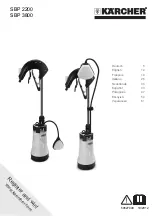
13
Operating Manual geoTHERM VWS/VWW 0020051547_02
GB
5.3
Description of the controller
The heating engineer will have set all the operating pa-
rameters to preset values during commissioning, so that
the heat pump can function optimally. However you can
individually set and adapt the operating modes and
functions afterwards.
5.3.1 Possible
system
circuits
The controller can control the following system circuits:
– a heating circuit,
– an indirectly heated hot water storage tank,
– a hot water circulation pump,
– a buffer circuit.
In order to extend the system a buffer circuit can be
used to connect up to six additional mixer circuit mod-
ules VR 60 (accessories) each with two mixer circuits.
The controller on the operating panel of the heat pump
is used to programme the mixer circuits.
In order to operate under comfortable conditions you
can connect the remote control units VR 90 for the first
eight heating circuits.
5.3.2 Energy
balance
controller
The energy balance controller is only applicable to hy-
draulics without buffer cylinder.
For economical and fault-free operation of a heat pump,
it is important to regiment the starting of the compres-
sor. The start-up of the compressor is the point at which
the highest loading occurs. With the help of the energy
balance controller it is possible to minimise starts of the
heat pump without compromising the comfort of a
pleasant room atmosphere.
As with other weather-controlled heating controllers the
controller determines a supply set target temperature
by capturing the outside temperature through a heating
curve. The energy balance calculation is carried out
based on this supply set target temperature and the
supply real temperature the difference of which is
measured per minute and added up:
1 degree minute [°min] = 1 K temperature difference in
the supply from 1 Minute (K = Kelvin)
The heat pump starts up at a defined heat deficit and
only switches off again when the supplied heat is equal
to the heat deficit.
The larger the preset negative numerical value is, the
longer the periods for which the compressor is kept run-
ning.
5.3.3 Charging principle buffer cylinder
The buffer cylinder is controlled depending on the sup-
ply set target temperature. The heat pump heats when
the temperature of the buffer cylinder head tempera-
ture sensor VF1 is smaller than the set target tempera-
ture. It continues to heat until the buffer cylinder floor
temperature sensor RF1 has reached the set target tem-
perature plus 2 K.
In the connection to a hot water cylinder charging the
buffer cylinder is also charged when the temperature of
the head temperature sensor VF1 is less than 2 K higher
than the set target temperature (premature reheating):
VF1 < T VL set + 2 K.
5.3.4 Resetting to factory settings
a
Caution!
Unintentional deletion of the specific
settings!
When you reset the control system to
the default setting specific settings in
the system could be deleted and the
system could shut down. The system
does not suffer damage.
• In the basic display on the graphic display press both
dials at the same time for min. 5 sec.
After that you can select whether to reset only the
timer programme or all values to the default settings.
5.3.5 Controller
structure
The
top-level display
is a
graphics display
. It is the
starting point for all the available displays. This display
reappears automatically if you do not actuate any of the
dials for a long time when setting values.
Controller operation is subdivided into four levels:
The
operator level
is specified for the operator.
In Sect. 5.4 all of the controller's displays are shown as
a flow diagram. A detailed description of the displays is
contained in Sect. 5.5.
The
code level
(menu C1 - C9, D1 - D5, I1 - I5 and A1 - A9)
is reserved for the engineer and protected by a code to
protect it from unintentional modification.
As the operator you can scroll through the menus of the
code level and view the system-specific setting parame-
ters however without changing the values.
In the menus C1 to C9 the engineer sets system-specific
parameters.
The menus D1 to D5 enable the engineer to operate and
test the heat pump in the diagnosis mode.
In menus I1 to I5 you are given general information on
the settings of the heat pump.
Menus A1 to A9 take the engineer through the installa-
tion menu to put the heat pump into operation.
Operation 5
Содержание geoTHERM VWS 61/2
Страница 1: ...geoTHERM ES GB...
Страница 2: ......
Страница 3: ...Para el usuario Instrucciones de uso geoTHERM VWS VWW Bomba de calor ES...
Страница 35: ...For the operator Operating Manual geoTHERM VWS VWW Heat pump GB...
Страница 66: ......
Страница 67: ......
Страница 68: ...0020051547_02 ESGB 072008...
















































